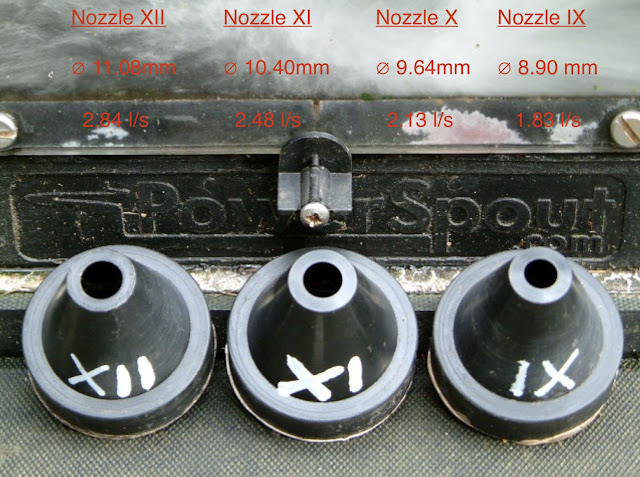Any opportunities to find efficiency improvements in an installation once the installation is completed are few. Most factors making for poor efficiency are built into the installation from the outset and are not readily changed. They often come from sub-optimal design and trying to save on expenditure, for example by opting for too small a penstock. This is always a temptation because the penstock is a significant cost burden but putting in too small a pipe leads to a loss of head pressure that will haunt the installation for its entire working life.
Soon after I first got my installation going, I measured the 'water to grid watt' efficiency* to be 50% and in an early diary entry I speculated that this figure came about because of component efficiencies** as follows:
- penstock efficiency @ 3 lps 0.95***
- manifold efficiency 0.98
- nozzle efficiency 0.98
- Pelton turbine efficiency 0.77
- turbine / alternator drive efficiency 1.00
- SmartDrive PMA alternator efficiency 0.80
- transmission line efficiency 0.98
- SMA 1200 inverter efficiency 0.90
From this list, the only two which gave opportunity for obtaining any improvement seemed to be the nozzle and the inverter.
Over the past 6 months I have been collecting data to investigate these two, the first by running with either one nozzle or two over the full flow range for my site, and the second by using a WindyBoy inverter in turbine mode and comparing with last year when a SunnyBoy in mppt mode was in use.
What I have found is that running on one nozzle gives a 2% efficiency improvement pretty well over the entire flow / power range:
I should add that when running a single nozzle it was always in the bottom position and when there were two nozzles, the top one only ever contributed 0.3 l/s, the bulk of the flow always being delivered via the bottom one.
As regards any benefit from changing inverters, - there really was none: the peak efficiency with the WindyBoy in two nozzle operation can be seen from the graph above to be a little over 49% and this is virtually identical (49.9%) to what I had observed the efficiency to be last year when using a SunnyBoy, also with two nozzles.
The small gain from using one nozzle rather than two is not unexpected:
- there is an energy loss which takes place at a nozzle and by having one rather than two nozzles, there is only one loss
- one nozzle in the bottom position leads to less 'windage' i.e. the loss from spray inside the casing
- there is a marginal gain in head from using the bottom nozzle position.
As a result of this study, I'm going to continue with one jet operation. I'll use the small top nozzle intermittently simply for the convenience of reducing the number of times I need to change the bottom nozzle to keep track of the ever changing seasonal flow.
This study doesn't provide a big step forward perhaps but nevertheless I thought the persuasiveness of the result interesting.
* The formula for calculating 'whole system' or 'water to watt' efficiency is:
Efficiency (%) = Power to grid (watts) x 100 / [ 9.81 x static head (m) x flow (l/s) ]
** Whole system efficiency is the product of multiplying together the efficiencies of all the components in the system; with the figures given this would make the whole system efficiency 0.496 (49.6%).
***This figure was 'guesstimated' before I had obtained precise measurements of the gross head and the head loss at full flow, which turned out to be just 0.6 m head of water. So the penstock efficiency is actually 98.9%. Such a good figure is explained by the first 69 m of penstock being 110mm o/d MDPE pipe rather than the 90 mm o/d pipe from which the rest is made.
This study doesn't provide a big step forward perhaps but nevertheless I thought the persuasiveness of the result interesting.
* The formula for calculating 'whole system' or 'water to watt' efficiency is:
Efficiency (%) = Power to grid (watts) x 100 / [ 9.81 x static head (m) x flow (l/s) ]
** Whole system efficiency is the product of multiplying together the efficiencies of all the components in the system; with the figures given this would make the whole system efficiency 0.496 (49.6%).
***This figure was 'guesstimated' before I had obtained precise measurements of the gross head and the head loss at full flow, which turned out to be just 0.6 m head of water. So the penstock efficiency is actually 98.9%. Such a good figure is explained by the first 69 m of penstock being 110mm o/d MDPE pipe rather than the 90 mm o/d pipe from which the rest is made.

